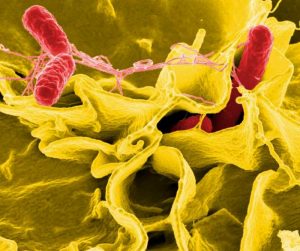By NewsDesk @infectiousdiseasenews
Ukraine health officials reported recently that during the first eight months of 2020, the country has seen 16 salmonella outbreaks, including four in Zaporizhia oblast, two in Ivano-Frankivsk oblast and one each in Vinnytsia, Dnipropetrovsk, Zakarpattia, Kirovohrad, Odesa, Poltava, Rivne, Sumy, Cherkasy oblasts and Kyiv.

In total, 2402 salmonella cases have been reported, Officials say the incidence rate per 100,000 population is 5.7, which is 41% lower than in the same period last year.
Salmonellosis is an infectious disease caused by a bacterium of the genus Salmonella.
The severity of the disease depends on the serotype, the susceptibility of the population and a number of other factors.
The source of the pathogen – animals (cattle, pigs, sheep, horses, waterfowl, chickens, reptiles, cats, dogs, domestic rodents), people with salmonellosis or healthy carriers.
Carrier status can last from a few days to several years.
The mechanism of infection is fecal-oral. Infection occurs through food, water and household routes.
Salmonellosis has a summer-autumn seasonality, which is associated with the activation during this period of the mechanism of bacterial transmission.
The incidence in cities is 2 times higher than in villages.
The incubation period ranges from 6 hours to 2-3 days.
The disease can be mild. However, in some cases, disease-related dehydration can be life-threatening.
Symptoms of salmonellosis: fever, headache, weakness, malaise, abdominal pain, nausea, vomiting, diarrhea.
Prevention of salmonellosis should include a wide range of veterinary, sanitary and anti-epidemic measures.
- Lyme Disease: University of Idaho leads research team studying movement of tick-borne disease
- Canada: Public Health Advisory issued, Increase in Gonorrhea cases in Nunavut
- New Jersey reports first two West Nile virus cases of year
- Chagas disease: Risk of developing cardiac disease doubles for asymptomatic infections
- African sleeping sickness: Togo eliminates as public health problem
- Antiviral used to treat cat coronavirus also works against SARS-CoV-2
- Rhode Island: White-tailed deer is first EEE positive mammal of 2020


One thought on “Ukraine reports 16 salmonella outbreaks so far this year”